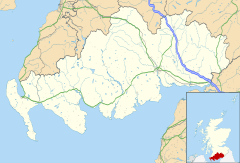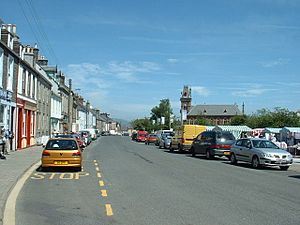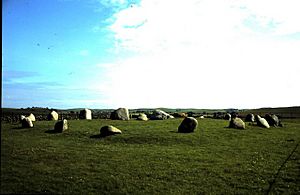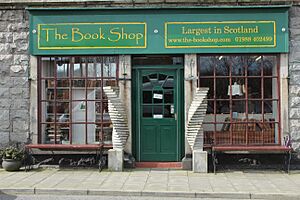Wigtown facts for kids
Quick facts for kids Wigtown
|
|
|---|---|
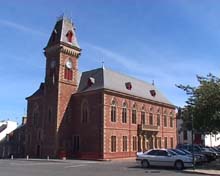 Wigtown County Buildings, once the main building for the Wigtownshire County Council |
|
| Population | 880 (2020) |
| OS grid reference | NX435555 |
| Council area | |
| Lieutenancy area | |
| Country | Scotland |
| Sovereign state | United Kingdom |
| Post town | NEWTON STEWART |
| Postcode district | DG8 |
| Dialling code | 01988 |
| Police | Dumfries and Galloway |
| Fire | Dumfries and Galloway |
| Ambulance | Scottish |
| EU Parliament | Scotland |
| UK Parliament |
|
| Scottish Parliament |
|
Wigtown is a town in Scotland. It used to be a special kind of town called a royal burgh. Wigtown is the main town of Wigtownshire and is part of the Dumfries and Galloway region.
You can find Wigtown east of Stranraer and south of Newton Stewart. It is famous as "Scotland's National Book Town". This means it has many second-hand bookshops. Every year, Wigtown also hosts a popular book festival. The town is located on the Machars peninsula.
Contents
Exploring Wigtown's Past
How Wigtown Got Its Name
The name Wigtown might come from old words. One idea is that it means 'dwelling place' from 'wic-ton' in Old English. Another idea is that it means 'Wigca’s farm'. This is similar to a town called Wigton in England. Some people also think the name comes from a Norse word 'Vik', meaning 'bay'. So, it could mean 'The town on the bay'.
Ancient Times: The Neolithic Age
The area around Wigtown has many old remains from prehistoric times. The most famous are the Torhousekie Standing Stones. This is a Neolithic stone circle built on a platform of smaller stones.
The circle has nineteen large stones, some up to 5 feet tall. They are lined up with the winter solstice. Inside the circle, there is a ring cairn with three even larger stones. These stones are some of the best-preserved sites in Britain.
Wigtown as a Medieval Town
In the 17th century, a minister named Andrew Symson thought the first settlement was on low sands. These sands were between Wigtown and Creetown.
The medieval town had a wide main street. This street changed a lot over time. Wigtown was a small port in the 15th century. Trade in this part of Scotland was never very big.
King David II gave the royal burgh status to Sir Malcolm Fleming in 1341. Later, in 1372, Wigtown became part of the Earls of Douglas lands. But it became a royal burgh again in 1455. Its special status was officially recognized by a royal charter in 1457.
Wigtown was made a royal burgh in 1469. This means it had special rights from the king. The town sent representatives to the Scottish Parliament from 1469. It also attended the Convention of Royal Burghs from 1575. Trade was still small; in 1500-01, only two ships visited Wigtown and Kirkcudbright.
The Town's Old Gates
Wigtown used to have two main gates. Some people say these gates were closed at night. This would have made a large area to keep cattle safe. The East Port was near a specific spot on old maps. The West Port was opposite the High Vennel (a narrow street). Parts of it could still be seen in the 1930s.
These gates were made of houses that stuck out across the street. A gate was placed in the middle. In the late 1800s, one of these houses was still at the West Port. People thought it looked ugly. In 1742, a well was dug outside the West Port. This well was probably the one known as the White Pump.
In 1761, the town council decided the gates were "hurtful to the place." They made it hard to carry coffins through. So, they ordered the gates to be pulled down. The stones were saved for future use by the town.
Wigtown in the 13th Century
The town is mentioned in a document from 1292. The area around Wigtown had a sheriff by 1263. This suggests that Wigtown was likely a recognized town during the time of King Alexander III.
Old Friary and Wells
There were two wells, one at the castle and one at the friary. A Dominican friary, called Blackfriars, was started in 1267. It was founded by Devorgilla, who was the mother of King John Balliol. The friars were given rights to fish in the River Bladnoch. In 1526, King James V gave them more fishing rights. The town's mill was also located on this fishing spot.
Wigtown Castle
Wigtown Castle existed by 1291. It was on flat land near the River Bladnoch. The town and church were on a hill, which was unusual. Nothing is left of the castle today. But old maps and excavations show it was a large, defended area. It might have been a castle built by Edward I of England.
The castle's history is mostly unknown. It might have been used by the leaders of Clan MacDowall. Robert the Bruce might have ordered it to be destroyed. The castle was likely used as a quarry for building materials. This explains why it completely disappeared.
Trade and Town Life in the 15th and 16th Centuries
Wigtown and Kirkcudbright were big rivals for trade on the west coast. In 1471, Wigtown exported goods worth £17 10s 0d. Kirkcudbright exported £23 15s 0d. Later, Wigtown exported more hides than Kirkcudbright. Wigtown's rise hurt Kirkcudbright's trade. However, Wigtown also declined over time. This might be because Wigtown did not get involved in the herring trade. Herring was a major export for other west coast ports. Wigtown was also a traditional trading town. Its special trading rights were threatened by Whithorn.
The first mention of Wigtown's market cross and tron (a public weighing machine) is from 1457. The market cross stood in front of the old court house. It was moved for a short time in the 18th century. A second market cross was put up in the main street in 1816. Later, the original cross was repaired and moved next to the second one.
An early mention of a tollbooth (a town hall and jail) in Wigtown is from 1591. This building might have been blown up in the 18th century. This made way for the market house. This market house was later replaced by the current county buildings. The Wigtown County Buildings were built in 1862. They have a unique French-style design. The county buildings were repaired in 2002-2003.
Wigtown in the 17th Century
Andrew Symson, a minister, described Wigtown in 1684. He said it was a well-built town with a large, wide street. By the late 1600s, Wigtown Market was not very busy. In 1683, the town council tried to get more people to come to the weekly market. They wanted to stop people from selling goods before the market opened. But this did not work much. Symson noted that the town had "small trading."
A report in 1692 said the town had no weekly market. It did have four yearly fairs. The market facilities were also poor, with no covered area. In recent years, Wigtown has held a market in the square during summer. In winter, it is held in the county buildings.
Wigtown's economic position declined during the 17th century. In 1597, Wigtown's tax was 15 shillings. By 1692, it had dropped to six shillings. The 1692 report said there was no foreign trade. The town owned no ships or boats. Trade within Scotland was "very considerable." Goods came from Ayr, Glasgow, and Dumfries.
The Wigtown Martyrs
There are monuments in Wigtown to the 'Wigtown Martyrs'. This sad event happened during "The Killing Times" in the 17th century. During this time, people called Covenanters were persecuted. Margaret McLachlan, an elderly woman, and Margaret Wilson, a teenager, were sentenced to death. They were tied to stakes in the tidal channel of the River Bladnoch. They were drowned by the incoming tide.
The plan was for the younger woman to give up her beliefs after watching the older woman drown. But this did not work, and both died. This execution was carried out by soldiers. Their story is told in different books. It says the women were betrayed. After about a month in prison, they were tried as rebels. Their story was collected by Robert Wodrow in his book History of the Sufferings of the Church of Scotland.
Wigtown in the 18th Century
In the 18th century, Wigtown was mainly a farming town. It served the countryside around it. Like other towns in Galloway, Wigtown did not grow much. The population of the area was 1,032 in 1755. It was 1,350 in 1739. The population was decreasing in the countryside. But it was increasing in the town. This was because farms got bigger, forcing workers to move to town. Also, Irish immigrants moved there.
People in Wigtown made a living in different ways. An observer in the 18th century, Samuel Robinson, noted that Wigtown was good for smuggling goods. This was because of its location near the sea. The town council in 1774 knew about the "pernicious and fatal consequences" of smuggling. They especially disliked smuggled tea from the Isle of Man. The council also said drinking tea and brandy was bad. They said it took money away from the county. This money could be used to make their own wool.
Despite this, Wigtown only started to have industries at the end of the century. Two small wool and cotton factories started in the early 1790s. The wool industry was stronger than the cotton one. Both exported goods to England.
Most houses in Wigtown were simple in the 18th century. They were thatched and one storey high. Each house had a pile of waste in front of it. By the end of the 19th century, houses were very different from each other. Some had pointed roofs, others had large fronts with small windows. Some even had outside stairs.
Learning in Wigtown
Wigtown Primary School is on New Road. The school building dates back to 1850. It has been changed and made bigger since then. Before 1850, a grammar school taught all ages in a building built in 1712.
Places of Worship
- Wigtown Parish Church was built in 1858. It is in the Gothic Revival style.
- Sacred Heart Catholic Church was finished in 1879. It was also designed in the Gothic Revival style.
- Wigtown Quaker Meeting House is at Chapel Court, South Main Street.
- Wigtown Baptist Church is in Southfield Lane.
- An old church called Wigtown West Church of Scotland was built in 1750. It was later taken down.
Landmarks and Culture in Wigtown
Wigtown is less than 1 kilometre from Bladnoch. This village has a distillery that makes whisky. You can fish for Atlantic salmon in the River Bladnoch. It is known as one of Scotland's best rivers for spring fish. The river meets the River Cree in Wigtown Bay. This area has a large salt marsh. It is a Local Nature Reserve (LNR).
Wigtown Bay is the biggest LNR in Britain. It has lots of wildlife, especially birds. Some people watch birds from special viewing hides near the harbour. Others, called wildfowlers, hunt ducks and geese. This is part of conservation work by the Wigtown Wildfowling Club. The first ospreys to return to Galloway in over 100 years arrived in 2004. You can watch a live camera feed of their nest at the Wigtown County Buildings.
East of Wigtown is The Martyrs' Stake. This monument marks where the Wigtown Martyrs were drowned. Their graves are in the Parish Church cemetery. There is a small cell in the County Buildings. This cell is where they were held before they died. It is the only part left of a much older building.
Fun Events in Wigtown
The Wigtown Book Festival is a ten-day festival about books. It happens every year in Wigtown. The first festival was in 1999. The Wigtown Agricultural Show is another yearly event. It happens in August and has been held since 1811.
Wigtown's Bookshops
In 2018, Wigtown had 13 bookshops. One of them sold books by mail. The town has its own group for booksellers. It is thought that Wigtown has hundreds of thousands of books.
The Old Bank bookshop is in a building that used to be a bank and customs house. The Bookshop in Wigtown is Scotland's biggest second-hand bookshop. It is said to have a mile of shelves and about 100,000 books. The owner, Shaun Bythell, wrote a book about his experiences selling books there.
The Open Book is a special bookshop. Customers can take charge of the shop for a short time. They can also live in the apartment above the shop.
Famous People from Wigtown
Many interesting people have connections to Wigtown:
- John McConnell Black, a botanist and linguist.
- Robert Cance, who was a member of the Wisconsin State Assembly in the USA.
- Helen D'Oyly Carte, a hotel owner and theatre producer.
- James Robertson Justice, an actor who had family ties to the area.
- Dave Kevan, a professional football player.
- Paul Laverty, a famous screenwriter who grew up in Wigtown.
- Adrian J McDowall, a BAFTA award-winning film and TV director.
- John McFadyean, a veterinary surgeon and professor.
- Louis McGuffie, a soldier who received the Victoria Cross.
- Ian Niall, an author. A local pub is named after his book, The Wigtown Ploughman.
- Graeme Parker, a hoof trimmer and YouTuber known as The Hoof GP.
- Mary Broadfoot Walker, a doctor known for her work on a muscle disease.
- Margaret Wilson, one of the 17th-century Covenanter martyrs.
Images for kids
See also
 In Spanish: Wigtown para niños
In Spanish: Wigtown para niños


